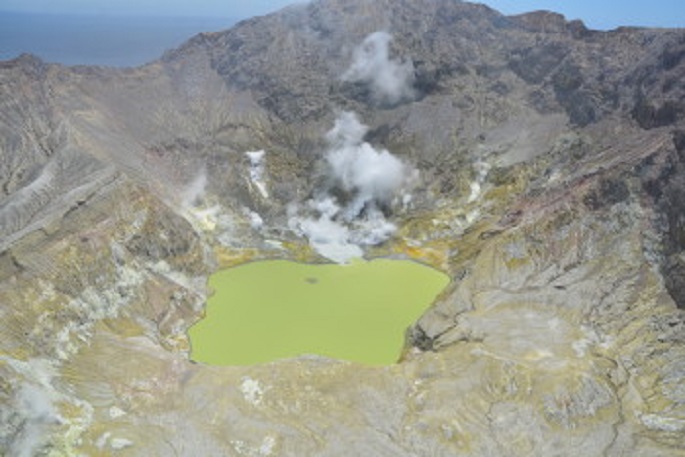Gas and observation flights over the past two months confirm the level of activity at Whakaari/White Island remains low.
The primary surface activity is still mostly minor steam and gas emissions from the active vents, says Duty Volcanologist Agnes Mazot.
"No eruptive activity was observed in the past few months, and beside some drop in water level in the crater lake, the active crater has not changed significantly."
The Volcanic Alert Level remains at 2.
Observations from the most recent observation flight on Friday December 15 2023 show that the steam and gas plumes continue to originate from the cluster of active fumaroles on the west shore of the lake.
Discharge rates are in a similar range to previous observations over the last year.
The water level of the lake has dropped, isolating a minor pool from the main body of the lake. This pool and one immediately to the north are discoloured as gas passing through disturbs the sediments.
When local atmospheric conditions allow, steam and gas plumes can be seen above the island from the coast and the Whakatāne web camera.
Based on these coastal observations and our regular flights, there has been no evidence of ash emission or eruptive activity over the past few months.
Gas emission rates and steam discharge remain within typical values, tending to the moderate - low range during the year. Measurements from regular observation flights have recorded a general decline in the temperatures from the larger steam and gas vents through the year.
"We will continue to make regular observation and gas measurement flights to monitor the status of the island," says Agnes.
"These are complimented by satellite-based ground deformation data approximately every 10 days that allows us to observe ground deformation trends.
"We also get daily satellite-based Sulphur Dioxide (SO2) emission measurements, although this technique is not as sensitive as our gas measurement flights. Neither of these satellite techniques have detected significant changes in the overall activity at the volcano over the past few months."
The Volcanic Alert Level remains at Level 2 (moderate to heightened unrest) and the Aviation Colour Code remains at Yellow, "acknowledging the current level of activity, but also continuing to consider the greater level of uncertainty in our interpretation due to the current lack of consistent, usable real-time data", says Agnes.
The Volcanic Alert Level reflects the current level of volcanic unrest or activity and is not a forecast of future activity.
"While Volcanic Alert Level 2 is mostly associated with volcanic unrest hazards (including discharge of steam and hot volcanic gases, earthquakes, landslides, and hydrothermal activity), potential for eruption hazards also exists and eruptions can still occur with little or no warning."
Further information about the Volcanic Alert Levels and what they mean can be found here.
GNS Science’s National Geohazards Monitoring Centre and Volcano Monitoring Group, through the GeoNet programme, continue to monitor Whakaari/White Island for further changes in unrest.



0 comments
Leave a Comment
You must be logged in to make a comment.